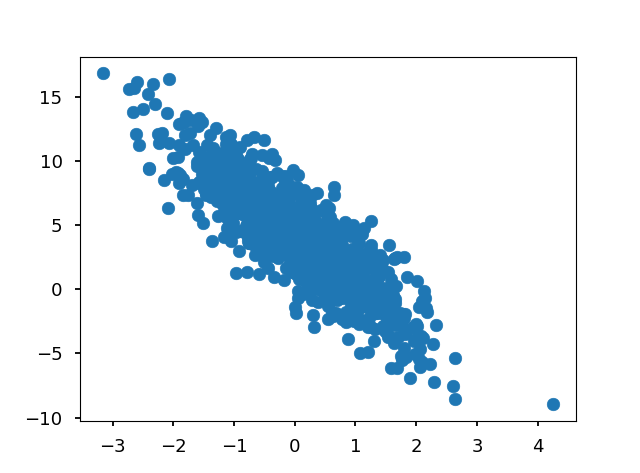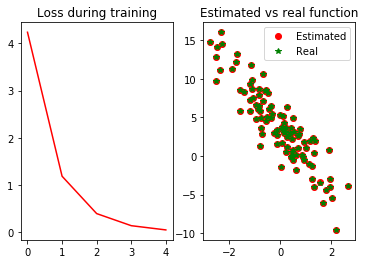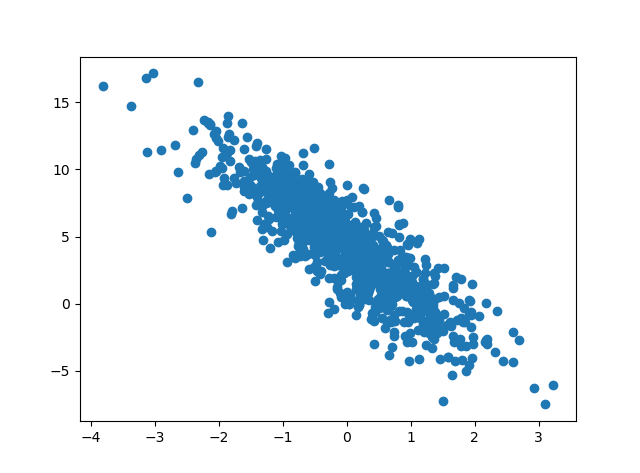线性回归
给定一个数据点集合X和对应的目标值y,线性模型的目标就是找到一条使用向量w和位移b描述的线,来尽可能地近似每个样本X[i]和y[i]。用数学符号来表示就是:
y^=Xw+by^=Xw+b
并最小化所有数据点上的平方误差
∑i=1n(y^i−yi)2.
我们使用一个数据集来尽量简单地解释清楚,真实的模型是什么样的。具体来说,我们使用如下方法来生成数据;随机数值 X[i],其相应的标注为 y[i]:
y[i] = 2 * X[i][0] - 3.4 * X[i][1] + 4.2 + noise
创建数据集
from mxnet import ndarray as nd from mxnet import autograd num_inputs = 2 num_examples = 1000 true_w = [2, -3.4] true_b = 4.2 X = nd.random_normal(shape=(num_examples, num_inputs)) y = true_w[0] * X[:, 0] + true_w[1] * X[:, 1] + true_b y += .01 * nd.random_normal(shape=y.shape) print(X[0], y[0])
import matplotlib.pyplot as plt plt.scatter(X[:, 1].asnumpy(),y.asnumpy()) plt.show()

读取数据
import random batch_size = 10 def data_iter(): # 产生一个随机索引 idx = list(range(num_examples)) random.shuffle(idx) for i in range(0, num_examples, batch_size): j = nd.array(idx[i:min(i+batch_size,num_examples)]) yield nd.take(X, j), nd.take(y, j) for data, label in data_iter(): print(data, label) break
[[-1.0070884 0.1334201 ] [ 1.60204 0.10594607] [ 0.21170591 -0.12287328] [-1.3481458 1.5419681 ] [ 0.882522 0.23611583] [-1.5105119 0.2063509 ] [ 0.50767344 0.07797765] [-1.0767087 0.18912305] [-2.0252197 0.14331104] [-0.1959934 -0.6187245 ]] <NDArray 10x2 @cpu(0)> [ 1.7316033 7.0403533 5.0448837 -3.739245 5.16984 0.483731 4.943021 1.4079181 -0.34202975 5.9089913 ] <NDArray 10 @cpu(0)>
随机初始化模型参数
w = nd.random_normal(shape=(num_inputs, 1)) b = nd.zeros((1,)) params = [w, b] for param in params: param.attach_grad()
定义模型、损失函数、优化
def net(X): return nd.dot(X, w) + b def square_loss(yhat, y): # 注意这里我们把y变形成yhat的形状来避免矩阵形状的自动转换 return (yhat - y.reshape(yhat.shape)) ** 2 def SGD(params, lr): for param in params: param[:] = param - lr * param.grad
训练
# 模型函数
def real_fn(X): return 2 * X[:, 0] - 3.4 * X[:, 1] + 4.2 # 绘制损失随训练次数降低的折线图,以及预测值和真实值的散点图 def plot(losses, X, sample_size=100): xs = list(range(len(losses))) f, (fg1, fg2) = plt.subplots(1, 2) fg1.set_title('Loss during training') fg1.plot(xs, losses, '-r') fg2.set_title('Estimated vs real function') fg2.plot(X[:sample_size, 1].asnumpy(), net(X[:sample_size, :]).asnumpy(), 'or', label='Estimated') fg2.plot(X[:sample_size, 1].asnumpy(), real_fn(X[:sample_size, :]).asnumpy(), '*g', label='Real') fg2.legend() plt.show()
epochs = 5 learning_rate = .001 niter = 0 losses = [] moving_loss = 0 smoothing_constant = .01 # 训练 for e in range(epochs): total_loss = 0 for data, label in data_iter(): with autograd.record(): output = net(data) loss = square_loss(output, label) loss.backward() SGD(params, learning_rate) total_loss += nd.sum(loss).asscalar() # 记录每读取一个数据点后,损失的移动平均值的变化; niter +=1 curr_loss = nd.mean(loss).asscalar() moving_loss = (1 - smoothing_constant) * moving_loss + (smoothing_constant) * curr_loss # correct the bias from the moving averages est_loss = moving_loss/(1-(1-smoothing_constant)**niter) if (niter + 1) % 100 == 0: losses.append(est_loss) print("Epoch %s, batch %s. Moving avg of loss: %s. Average loss: %f" % (e, niter, est_loss, total_loss/num_examples)) plot(losses, X)
结果:

true_w, w
true_b, b
*********************************************************************************************************
使用高层抽象包gluon实现线性回归
创建数据集及读取数据:
from mxnet import ndarray as nd from mxnet import autograd from mxnet import gluon num_inputs = 2 num_examples = 1000 true_w = [2, -3.4] true_b = 4.2 X = nd.random_normal(shape=(num_examples, num_inputs)) y = true_w[0] * X[:, 0] + true_w[1] * X[:, 1] + true_b y += .01 * nd.random_normal(shape=y.shape) batch_size = 10 dataset = gluon.data.ArrayDataset(X, y) data_iter = gluon.data.DataLoader(dataset, batch_size, shuffle=True) for data, label in data_iter: print(data, label) break
[[-0.24494731 -0.81835526] [ 0.2704266 -0.02764991] [-0.5286131 -1.2727908 ] [-0.6861068 -0.5157651 ] [-1.3930596 0.3703239 ] [-0.33812827 -2.2536128 ] [-0.24514636 0.74520713] [-1.4742857 0.82008356] [-0.7820533 -0.28321254] [-1.2232946 -0.11667698]] <NDArray 10x2 @cpu(0)> [ 6.490005 4.83796 7.476795 4.5888553 0.14437589 11.18529 1.1644824 -1.5609252 3.591857 2.1701815 ] <NDArray 10 @cpu(0)>
import matplotlib.pyplot as plt plt.scatter(X[:, 1].asnumpy(),y.asnumpy()) plt.show()

定义模型,初始化模型参数,损失函数,优化
gluon提供大量预定义的层,我们只需要关注使用哪些层来构建模型。例如线性模型就是使用对应的
Dense
层;之所以称为dense层,是因为输入的所有节点都与后续的节点相连。对于初学者来说,构建模型最简单的办法是利用Sequential来所有层串起来。输入数据之后,Sequential会依次执行每一层,并将前一层的输出,作为输入提供给后面的层。
net = gluon.nn.Sequential() net.add(gluon.nn.Dense(1)) net.initialize() square_loss = gluon.loss.L2Loss() ---gluon提供了平方误差函数 trainer = gluon.Trainer( net.collect_params(), 'sgd', {'learning_rate': 0.1})
训练
在完成初始设置后,训练过程本身和前面没有太多区别,唯一的不同在于我们不再是调用SGD,而是trainer.step来更新模型。使用gluon使模型训练更为简洁。
epochs = 5 batch_size = 10 for e in range(epochs): total_loss = 0 for data, label in data_iter: with autograd.record(): output = net(data) loss = square_loss(output, label) loss.backward() trainer.step(batch_size) total_loss += nd.sum(loss).asscalar() print("Epoch %d, average loss: %f" % (e, total_loss/num_examples))
Epoch 0, average loss: 0.902538 Epoch 1, average loss: 0.000050 Epoch 2, average loss: 0.000050 Epoch 3, average loss: 0.000050 Epoch 4, average loss: 0.000050
dense = net[0] true_w, dense.weight.data() true_b, dense.bias.data()
([2, -3.4], [[ 1.9994318 -3.399815 ]] <NDArray 1x2 @cpu(0)>)
(4.2, [4.200489] <NDArray 1 @cpu(0)>)




























 820
820

 被折叠的 条评论
为什么被折叠?
被折叠的 条评论
为什么被折叠?








